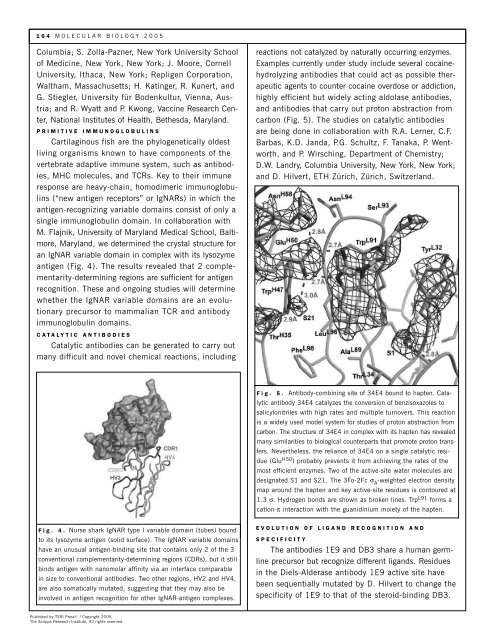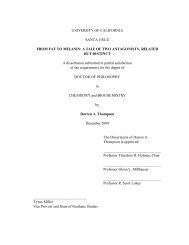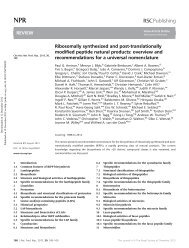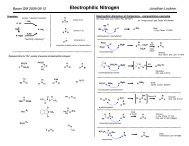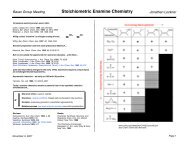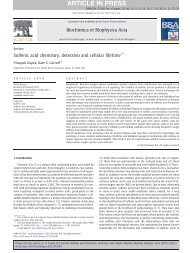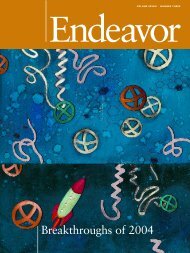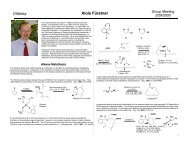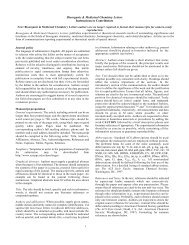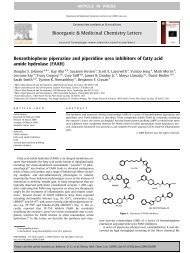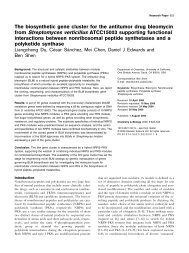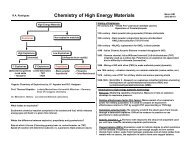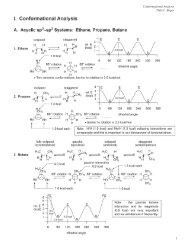Molecular Biology - The Scripps Research Institute
Molecular Biology - The Scripps Research Institute
Molecular Biology - The Scripps Research Institute
Create successful ePaper yourself
Turn your PDF publications into a flip-book with our unique Google optimized e-Paper software.
164 MOLECULAR BIOLOGY 2005<br />
Columbia; S. Zolla-Pazner, New York University School<br />
of Medicine, New York, New York; J. Moore, Cornell<br />
University, Ithaca, New York; Repligen Corporation,<br />
Waltham, Massachusetts; H. Katinger, R. Kunert, and<br />
G. Stiegler, University für Bodenkultur, Vienna, Austria;<br />
and R. Wyatt and P. Kwong, Vaccine <strong>Research</strong> Center,<br />
National <strong>Institute</strong>s of Health, Bethesda, Maryland.<br />
PRIMITIVE IMMUNOGLOBULINS<br />
Cartilaginous fish are the phylogenetically oldest<br />
living organisms known to have components of the<br />
vertebrate adaptive immune system, such as antibodies,<br />
MHC molecules, and TCRs. Key to their immune<br />
response are heavy-chain, homodimeric immunoglobulins<br />
(“new antigen receptors” or IgNARs) in which the<br />
antigen-recognizing variable domains consist of only a<br />
single immunoglobulin domain. In collaboration with<br />
M. Flajnik, University of Maryland Medical School, Baltimore,<br />
Maryland, we determined the crystal structure for<br />
an IgNAR variable domain in complex with its lysozyme<br />
antigen (Fig. 4). <strong>The</strong> results revealed that 2 complementarity-determining<br />
regions are sufficient for antigen<br />
recognition. <strong>The</strong>se and ongoing studies will determine<br />
whether the IgNAR variable domains are an evolutionary<br />
precursor to mammalian TCR and antibody<br />
immunoglobulin domains.<br />
CATALYTIC ANTIBODIES<br />
Catalytic antibodies can be generated to carry out<br />
many difficult and novel chemical reactions, including<br />
Fig. 4. Nurse shark IgNAR type I variable domain (tubes) bound<br />
to its lysozyme antigen (solid surface). <strong>The</strong> IgNAR variable domains<br />
have an unusual antigen-binding site that contains only 2 of the 3<br />
conventional complementarity-determining regions (CDRs), but it still<br />
binds antigen with nanomolar affinity via an interface comparable<br />
in size to conventional antibodies. Two other regions, HV2 and HV4,<br />
are also somatically mutated, suggesting that they may also be<br />
involved in antigen recognition for other IgNAR-antigen complexes.<br />
Published by TSRI Press ®. ©Copyright 2005,<br />
<strong>The</strong> <strong>Scripps</strong> <strong>Research</strong> <strong>Institute</strong>. All rights reserved.<br />
reactions not catalyzed by naturally occurring enzymes.<br />
Examples currently under study include several cocainehydrolyzing<br />
antibodies that could act as possible therapeutic<br />
agents to counter cocaine overdose or addiction,<br />
highly efficient but widely acting aldolase antibodies,<br />
and antibodies that carry out proton abstraction from<br />
carbon (Fig. 5). <strong>The</strong> studies on catalytic antibodies<br />
are being done in collaboration with R.A. Lerner, C.F.<br />
Barbas, K.D. Janda, P.G. Schultz, F. Tanaka, P. Wentworth,<br />
and P. Wirsching, Department of Chemistry;<br />
D.W. Landry, Columbia University, New York, New York;<br />
and D. Hilvert, ETH Zürich, Zürich, Switzerland.<br />
Fig. 5. Antibody-combining site of 34E4 bound to hapten. Catalytic<br />
antibody 34E4 catalyzes the conversion of benzisoxazoles to<br />
salicylonitriles with high rates and multiple turnovers. This reaction<br />
is a widely used model system for studies of proton abstraction from<br />
carbon. <strong>The</strong> structure of 34E4 in complex with its hapten has revealed<br />
many similarities to biological counterparts that promote proton transfers.<br />
Nevertheless, the reliance of 34E4 on a single catalytic residue<br />
(GluH50 ) probably prevents it from achieving the rates of the<br />
most efficient enzymes. Two of the active-site water molecules are<br />
designated S1 and S21. <strong>The</strong> 3Fo-2Fc σA-weighted electron density<br />
map around the hapten and key active-site residues is contoured at<br />
1.3 σ. Hydrogen bonds are shown as broken lines. TrpL91 forms a<br />
cation-π interaction with the guanidinium moiety of the hapten.<br />
EVOLUTION OF LIGAND RECOGNITION AND<br />
SPECIFICITY<br />
<strong>The</strong> antibodies 1E9 and DB3 share a human germline<br />
precursor but recognize different ligands. Residues<br />
in the Diels-Alderase antibody 1E9 active site have<br />
been sequentially mutated by D. Hilvert to change the<br />
specificity of 1E9 to that of the steroid-binding DB3.


